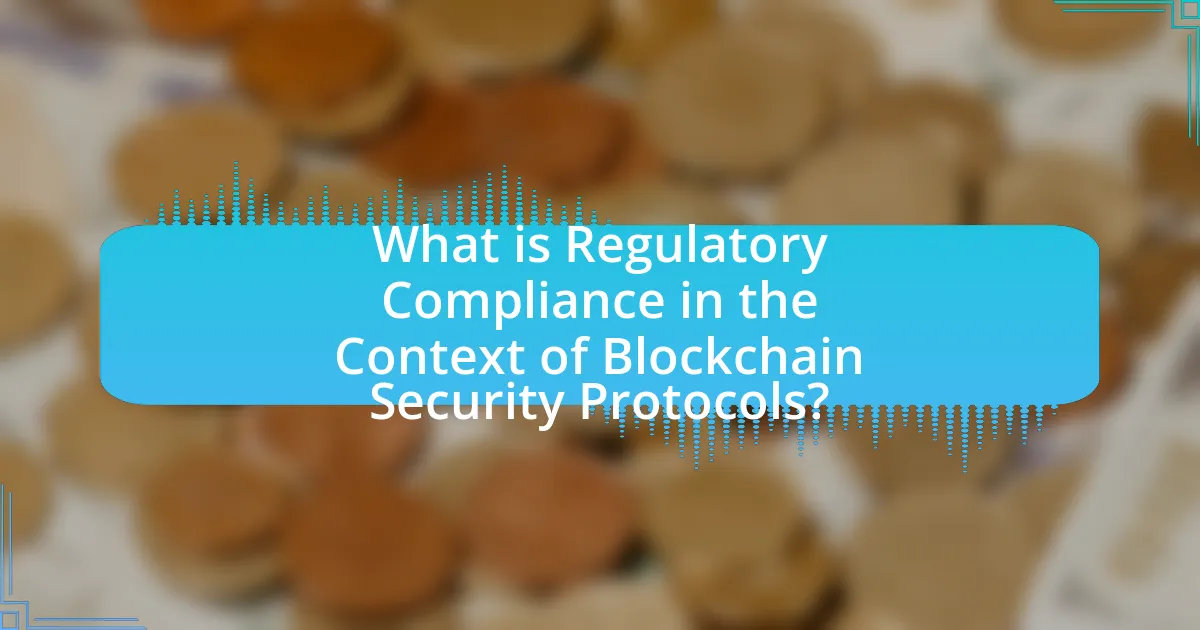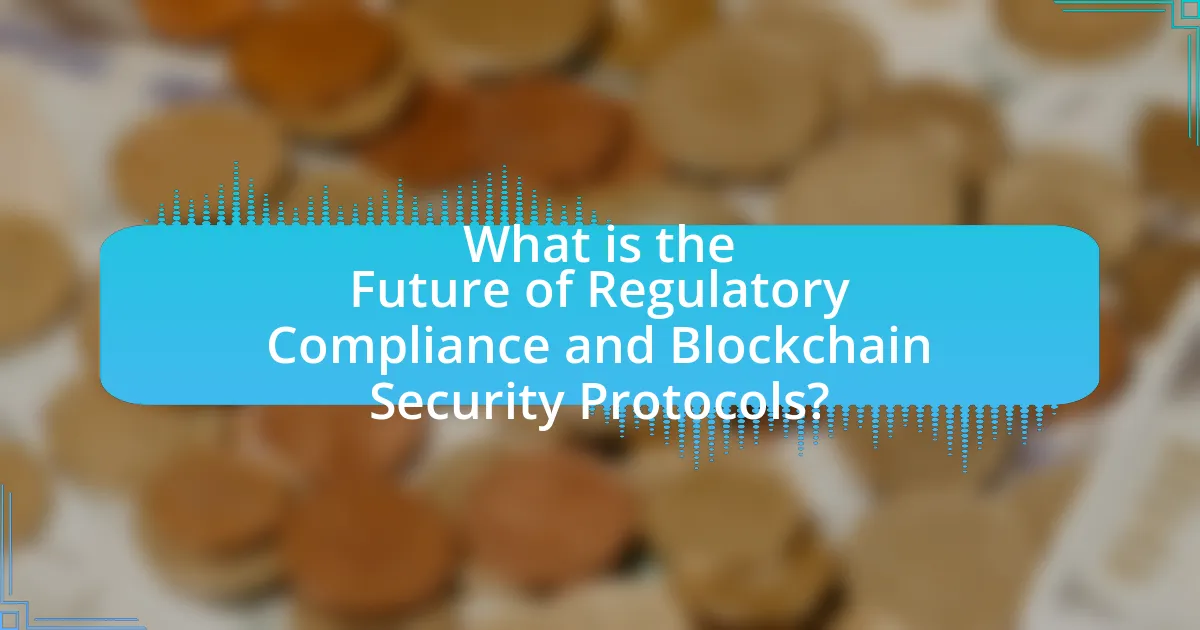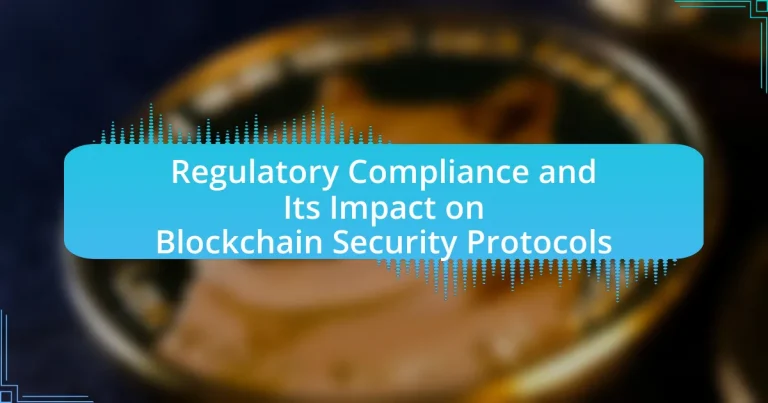Regulatory compliance in blockchain security protocols refers to the adherence to laws and guidelines governing blockchain technology, ensuring legal operation and addressing issues like data privacy and anti-money laundering. Key regulations impacting blockchain security include the General Data Protection Regulation (GDPR) and Financial Action Task Force (FATF) guidelines, which compel developers to implement robust security measures. The article explores the influence of compliance on blockchain security, the risks of non-compliance, and the challenges faced by developers in navigating varying regulations across jurisdictions. It also discusses the future of compliance in blockchain, emphasizing the role of emerging technologies and best practices for organizations to enhance their compliance strategies.

What is Regulatory Compliance in the Context of Blockchain Security Protocols?
Regulatory compliance in the context of blockchain security protocols refers to the adherence to laws, regulations, and guidelines that govern the use and implementation of blockchain technology. This compliance ensures that blockchain systems operate within legal frameworks, addressing issues such as data privacy, financial transactions, and anti-money laundering measures. For instance, the Financial Action Task Force (FATF) has established guidelines that require blockchain platforms to implement Know Your Customer (KYC) and Anti-Money Laundering (AML) protocols, thereby reinforcing the importance of regulatory compliance in maintaining security and trust in blockchain applications.
How does Regulatory Compliance influence Blockchain Security?
Regulatory compliance significantly influences blockchain security by establishing standards and protocols that enhance data integrity and user protection. Compliance requirements, such as those outlined in the General Data Protection Regulation (GDPR) and the Financial Action Task Force (FATF) guidelines, compel blockchain developers to implement robust security measures, including encryption and access controls. For instance, GDPR mandates that personal data must be processed securely, which drives the adoption of advanced cryptographic techniques in blockchain systems to ensure data confidentiality and integrity. Additionally, adherence to these regulations fosters trust among users and stakeholders, as compliance indicates a commitment to safeguarding sensitive information against breaches and unauthorized access.
What are the key regulations affecting Blockchain Security?
Key regulations affecting Blockchain Security include the General Data Protection Regulation (GDPR), the Financial Action Task Force (FATF) guidelines, and the Securities and Exchange Commission (SEC) regulations. GDPR mandates strict data protection and privacy measures for personal data, impacting how blockchain systems handle user information. FATF guidelines require cryptocurrency exchanges and service providers to implement anti-money laundering (AML) and know your customer (KYC) protocols, enhancing security against illicit activities. SEC regulations govern the issuance and trading of digital assets, ensuring compliance with securities laws, which influences the security frameworks of blockchain projects. These regulations collectively shape the security landscape of blockchain technology by enforcing standards that protect users and promote transparency.
How do these regulations vary across different jurisdictions?
Regulations regarding blockchain security protocols vary significantly across different jurisdictions, reflecting diverse legal frameworks and compliance requirements. For instance, the European Union’s General Data Protection Regulation (GDPR) imposes strict data privacy standards that affect blockchain implementations, while the United States has a more fragmented regulatory landscape, with states like Wyoming offering favorable laws for blockchain technology. Additionally, countries like China have implemented outright bans on cryptocurrency transactions, contrasting sharply with jurisdictions such as Switzerland, which fosters a supportive environment for blockchain innovation through clear regulatory guidelines. These variations highlight the necessity for organizations to adapt their compliance strategies based on the specific legal requirements of each jurisdiction they operate in.
Why is Regulatory Compliance important for Blockchain Security?
Regulatory compliance is crucial for blockchain security because it establishes a framework that ensures the integrity, transparency, and accountability of blockchain systems. Compliance with regulations, such as the General Data Protection Regulation (GDPR) and the Financial Action Task Force (FATF) guidelines, helps mitigate risks associated with fraud, data breaches, and illicit activities. For instance, adhering to these regulations can enhance user trust and promote wider adoption of blockchain technologies by demonstrating a commitment to security and ethical standards. Furthermore, regulatory compliance can prevent legal repercussions and financial penalties, as seen in cases where companies faced significant fines for non-compliance, thereby reinforcing the importance of integrating compliance into blockchain security protocols.
What risks are associated with non-compliance in Blockchain systems?
Non-compliance in Blockchain systems poses significant risks, including legal penalties, financial losses, and reputational damage. Legal penalties arise from failing to adhere to regulations such as anti-money laundering (AML) and know your customer (KYC) laws, which can result in fines or sanctions from regulatory bodies. Financial losses can occur due to the inability to operate legally, leading to lost business opportunities and potential lawsuits. Reputational damage stems from public perception and trust issues, as stakeholders may view non-compliance as a sign of poor governance or risk management. According to a report by the World Economic Forum, 10% of blockchain projects faced regulatory scrutiny, highlighting the importance of compliance in maintaining operational integrity and stakeholder confidence.
How does compliance enhance trust and credibility in Blockchain technology?
Compliance enhances trust and credibility in Blockchain technology by ensuring adherence to established legal and regulatory standards. When blockchain systems comply with regulations such as the General Data Protection Regulation (GDPR) or the Financial Action Task Force (FATF) guidelines, they demonstrate a commitment to transparency, security, and ethical practices. This adherence fosters confidence among users and stakeholders, as it mitigates risks associated with fraud, data breaches, and non-compliance penalties. For instance, a study by the Cambridge Centre for Alternative Finance found that regulatory compliance can significantly increase institutional investment in blockchain projects, indicating that compliance is a key factor in building trust and credibility within the ecosystem.

What are the Challenges of Achieving Regulatory Compliance in Blockchain?
Achieving regulatory compliance in blockchain faces several challenges, primarily due to the technology’s decentralized nature and the evolving regulatory landscape. The lack of standardized regulations across jurisdictions complicates compliance efforts, as blockchain operates globally while regulations may vary significantly from one region to another. Additionally, the pseudonymous nature of blockchain transactions raises concerns regarding anti-money laundering (AML) and know your customer (KYC) requirements, making it difficult for organizations to verify user identities effectively. Furthermore, the rapid pace of technological innovation in blockchain often outstrips the ability of regulatory bodies to create relevant and effective regulations, leading to uncertainty and potential non-compliance. These challenges are underscored by the fact that, as of 2023, only 10% of countries have comprehensive regulatory frameworks for blockchain technology, highlighting the significant gap between technology adoption and regulatory readiness.
What are the common obstacles faced by Blockchain developers regarding compliance?
Blockchain developers commonly face obstacles such as the lack of clear regulatory frameworks, which creates uncertainty in compliance requirements. This ambiguity can lead to difficulties in ensuring that blockchain applications adhere to varying laws across jurisdictions. Additionally, the rapidly evolving nature of technology outpaces regulatory updates, making it challenging for developers to stay compliant. Furthermore, the decentralized nature of blockchain complicates the enforcement of compliance measures, as it often involves multiple stakeholders with differing regulatory obligations. These factors collectively hinder the ability of developers to implement compliant solutions effectively.
How do technological limitations impact compliance efforts?
Technological limitations significantly hinder compliance efforts by restricting the ability to implement necessary regulatory frameworks effectively. For instance, inadequate data processing capabilities can lead to challenges in monitoring transactions in real-time, which is essential for compliance with regulations such as the Anti-Money Laundering (AML) laws. A study by the Financial Action Task Force (FATF) highlights that many blockchain systems lack the scalability to handle large volumes of transactions, making it difficult for organizations to meet compliance requirements efficiently. Additionally, insufficient interoperability between different blockchain platforms can create barriers to sharing compliance-related information, further complicating adherence to regulatory standards.
What role does the evolving regulatory landscape play in these challenges?
The evolving regulatory landscape significantly influences the challenges faced by blockchain security protocols. As regulations adapt to technological advancements, they create a framework that mandates compliance, which can lead to increased operational costs and complexity for organizations implementing blockchain solutions. For instance, the introduction of the General Data Protection Regulation (GDPR) in Europe has necessitated changes in how blockchain systems handle personal data, impacting their design and functionality. This regulatory shift underscores the need for blockchain developers to integrate compliance measures from the outset, thereby complicating the development process and potentially hindering innovation.
How can Blockchain projects effectively navigate compliance challenges?
Blockchain projects can effectively navigate compliance challenges by implementing robust regulatory frameworks and engaging with legal experts. These projects should conduct thorough risk assessments to identify applicable regulations, such as anti-money laundering (AML) and know your customer (KYC) requirements, which are critical for maintaining compliance in various jurisdictions. For instance, a study by the Cambridge Centre for Alternative Finance highlights that 90% of blockchain projects face regulatory scrutiny, emphasizing the need for proactive compliance strategies. Additionally, establishing partnerships with regulatory bodies can facilitate better understanding and adherence to evolving legal standards, ensuring that blockchain initiatives remain compliant while fostering innovation.
What best practices should be adopted for ensuring compliance?
To ensure compliance, organizations should adopt a comprehensive compliance management system that includes regular audits, employee training, and clear documentation of policies and procedures. Regular audits help identify gaps in compliance and ensure adherence to regulations, while employee training fosters a culture of compliance and awareness of legal obligations. Clear documentation provides a reference point for compliance standards and practices, facilitating accountability and transparency. According to a study by the Compliance and Ethics Institute, organizations with robust compliance programs experience 50% fewer compliance violations, demonstrating the effectiveness of these best practices in maintaining regulatory adherence.
How can collaboration with regulatory bodies improve compliance outcomes?
Collaboration with regulatory bodies can significantly improve compliance outcomes by ensuring that organizations align their practices with established legal standards and guidelines. This partnership facilitates a clearer understanding of regulatory expectations, which helps organizations implement effective compliance strategies. For instance, when companies engage with regulators during the development of blockchain technologies, they can receive timely feedback and guidance, reducing the risk of non-compliance. A study by the World Economic Forum highlights that proactive engagement with regulators can lead to a 30% reduction in compliance-related costs, demonstrating the tangible benefits of such collaboration.

What is the Future of Regulatory Compliance and Blockchain Security Protocols?
The future of regulatory compliance and blockchain security protocols is characterized by increased integration and adaptation to evolving legal frameworks. As governments worldwide recognize the potential of blockchain technology, they are developing regulations that ensure security, transparency, and accountability in blockchain applications. For instance, the European Union’s proposed Markets in Crypto-Assets (MiCA) regulation aims to create a comprehensive regulatory framework for cryptocurrencies and blockchain technologies, which will likely influence global standards. This regulatory evolution will necessitate the enhancement of blockchain security protocols to comply with new requirements, such as data privacy and anti-money laundering measures, thereby fostering a more secure and compliant blockchain ecosystem.
How are emerging technologies influencing compliance in Blockchain?
Emerging technologies are significantly influencing compliance in Blockchain by enhancing transparency, automating regulatory processes, and improving data security. Technologies such as artificial intelligence and machine learning enable real-time monitoring of transactions, which helps in identifying suspicious activities and ensuring adherence to regulatory standards. For instance, AI-driven analytics can assess compliance risks by analyzing vast amounts of transaction data, thereby facilitating proactive compliance measures. Additionally, smart contracts automate compliance checks, ensuring that transactions meet regulatory requirements without manual intervention. This integration of emerging technologies not only streamlines compliance processes but also reduces the risk of human error, ultimately fostering a more secure and compliant Blockchain environment.
What trends are shaping the future of regulatory frameworks for Blockchain?
Trends shaping the future of regulatory frameworks for Blockchain include increased government scrutiny, the push for global harmonization of regulations, and the rise of decentralized finance (DeFi) regulations. Governments worldwide are intensifying their oversight of Blockchain technologies to address concerns related to fraud, money laundering, and consumer protection. For instance, the Financial Action Task Force (FATF) has issued guidelines that encourage countries to implement regulations that align with international standards. Additionally, as Blockchain technology becomes more integrated into financial systems, there is a growing need for consistent regulations across jurisdictions to facilitate cross-border transactions and compliance. The emergence of DeFi has prompted regulators to consider new frameworks that specifically address the unique challenges posed by decentralized platforms, leading to the development of tailored regulatory approaches. These trends indicate a shift towards more comprehensive and adaptive regulatory environments that aim to balance innovation with risk management.
How might Blockchain technology evolve to meet future compliance demands?
Blockchain technology may evolve to meet future compliance demands by integrating advanced privacy features and regulatory frameworks directly into its protocols. This evolution will likely include the development of smart contracts that automatically enforce compliance with regulations, such as GDPR or AML, by embedding rules within the blockchain’s code. For instance, projects like Hyperledger Fabric already allow for permissioned access and data privacy, which can be tailored to meet specific regulatory requirements. Additionally, the use of zero-knowledge proofs can enable transactions to be verified without revealing sensitive information, thus aligning with compliance needs while maintaining user privacy. These advancements demonstrate a proactive approach to regulatory challenges, ensuring that blockchain remains a viable solution in a rapidly changing legal landscape.
What practical steps can organizations take to enhance compliance with Blockchain Security Protocols?
Organizations can enhance compliance with Blockchain Security Protocols by implementing comprehensive risk assessments, establishing clear governance frameworks, and conducting regular training for employees. Risk assessments identify vulnerabilities and ensure that security measures align with regulatory requirements, while governance frameworks provide structured oversight and accountability. Regular training equips employees with the knowledge to recognize security threats and adhere to protocols. According to a report by the World Economic Forum, organizations that prioritize these steps significantly reduce the likelihood of security breaches and improve compliance with evolving regulations.
How can organizations implement effective compliance monitoring systems?
Organizations can implement effective compliance monitoring systems by establishing clear policies, utilizing technology for real-time monitoring, and conducting regular audits. Clear policies define compliance expectations and procedures, ensuring all employees understand their responsibilities. Technology, such as compliance management software, enables organizations to track regulatory changes and monitor adherence in real time, which enhances responsiveness to compliance issues. Regular audits, both internal and external, provide an objective assessment of compliance practices, identifying gaps and areas for improvement. According to a study by the Association of Certified Fraud Examiners, organizations that implement robust compliance monitoring systems reduce the risk of non-compliance by up to 50%.
What resources are available for organizations seeking to improve their compliance strategies?
Organizations seeking to improve their compliance strategies can utilize various resources, including regulatory compliance software, industry guidelines, and training programs. Regulatory compliance software, such as LogicGate and ComplyAdvantage, helps automate compliance processes and monitor regulatory changes. Industry guidelines from organizations like the International Organization for Standardization (ISO) provide frameworks for best practices in compliance. Additionally, training programs offered by institutions like the Compliance Certification Board (CCB) equip employees with the necessary knowledge to adhere to compliance standards. These resources collectively enhance an organization’s ability to navigate complex regulatory environments effectively.

















